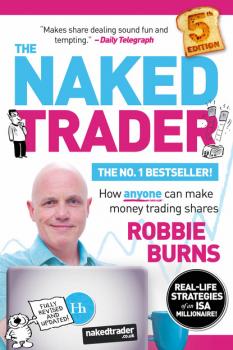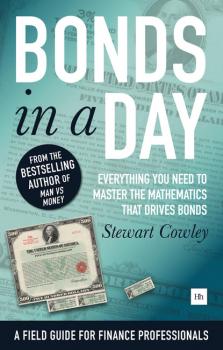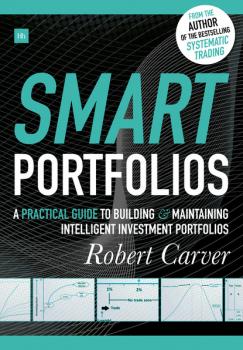Ценные бумаги, инвестиции
Различные книги в жанре Ценные бумаги, инвестицииBetter Value Investing
Practical and powerful improvements for value investors
Buying undervalued shares and selling when the price is many times greater has a natural appeal – and research shows it works. But not all value investors are successful. As Andrew Hunt shows in this must-read new book, many are guilty of common errors in their planning and execution and these critically undermine their success.
<i>Better Value Investing</i> provides a straightforward framework to help all value investors improve, showing them what to focus on and what to cut out in order to be successful.
Supported by the latest empirical research, 15 years of real investing experience, studies of what the top investors have said and done, and wide reading, Andrew Hunt reveals:
– how financial strength is at the heart of value investing – why to invest like an owner – the importance of contrarianism – why you should buy only the very best bargains – the essentials of constructing and managing a portfolio – how checklists control the process and keep the value investor on track.
This concise guide to honing the craft of value investing is essential reading for all value investors new and old. With its help you can concentrate on what is important, cut out errors and achieve what you set out to do, making you a better value investor.
Return of the Active Manager
Emotional behavior and biases run throughout financial markets. This is the diagnosis of behavioral finance.
But it is not enough to know that investors make biased decisions. What do we do about it? How do we move beyond diagnosis, to prescription?
In this groundbreaking new book, investing and behavioural finance experts Thomas Howard and Jason A. Voss plug this void and show the new way ahead for investment managers and advisors. <i>Return of the Active Manager</i> provides a set of tools for investment professionals to overcome and take advantage of behavioral biases.
Across seven compelling chapters, <i>Return of the Active Manager</i> details actionable advice on topics such as behaviourally-enhanced fundamental analysis, active equity fund evaluation and selection, harnessing big data, and investment firm structure. You learn how to exploit behavioural price distortions, how to recognise and avoid behavioural biases (in both yourself and clients), how to extract behavioral insights from the executives of prospective investments, and how manager behaviour can be used to predict future fund performance.
An indispensable tool, <i>Return of the Active Manager</i> rationalises the financial markets and prescribes actionable strategies that build on the lessons of behavioural finance.
The Naked Trader
Ever thought about investing in shares but got frustrated by all the gobbledygook? Bored by all the jargon? Then <i>The Naked Trader</i> is for you! This is the book on stock market investing that you can actually enjoy, written in plain English, packed with real-life trading examples and full of candid advice that you just can't get anywhere else.
In this completely updated and expanded new edition, Robbie Burns (aka the Naked Trader) gives you the lowdown on what you need to make money from today's markets without having to sit at a screen all day or swallow a financial dictionary. Even better, he shows you how to do it all tax-free!
The first four editions of <i>The Naked Trader</i> flew off the shelves as glowing reviews mounted up. This brand-new edition contains even more of what made it so popular. There are more exclusive tips and ideas, more winning trades shown from start to finish, and more real-life trader tales of triumph and disaster. Not to mention tons of proven strategies that you can use to make money in the markets and a breakdown of some of the trades that have helped Robbie make more than £3 million tax-free.
In between cups of tea, rounds of toast and watching <i>Four in a Bed</i>, Robbie tells you all you need to know to become a successful trader: from how to find good shares in the first place, to the best times to buy and sell, as well as how to make sure you have the right mindset for long-term success. You can also find out how Robbie has made money during market meltdowns – and what his biggest mistakes have been, so that you can avoid them.
If you're a complete beginner, <i>The Naked Trader</i> is the best place to start. But it's also absolutely perfect if you're already trading and want to learn some new, common-sense trading ideas that really work.
So whether you just want to make a few quid on the side while you're at work, or want to go on to make money from the markets full time and quit work like Robbie, <i>The Naked Trader</i> is everything you've been looking for. Grab some tea and toast and start trading the naked way!
The Sceptical Investor
Everyone wants to be a contrarian investor.
From the hedge funds who bet against the US housing market in the run up to 2008, to George Soros’s billion-dollar bet against the Bank of England in 1992, some of the most famous and most profitable trades in history have been contrarian calls.
And with the relentless growth of passive investing – investors blindly following the market – the opportunities for a smart investor to profit by betting against the crowd should be greater than ever.
Yet being a contrarian is hard work.
It takes patience, the conviction to stand by an unpopular viewpoint, and the mental toughness to endure being 'wrong' for prolonged periods of time. Standing out from the crowd goes against our every natural instinct.
Which is, of course, why it works.
So how do you go about it? There is no single, mechanical investment approach that marks an investor out as a contrarian. Instead, you need to adopt a sceptical mindset: a flexible mode of thinking that allows you to stand back and spot when the market’s view of the world is badly out of touch with reality – and the best way to profit when reality eventually reasserts itself.
In The Sceptical Investor, John Stepek, executive editor of MoneyWeek, pulls together the latest research on behavioural finance, and examples from well-known contrarian investors, to offer practical techniques to help you to spot opportunities in common investment situations, from turnaround plays to bubbles and busts, that others in the market miss.
It won't make you popular and it won't make you famous. But it will make you money.
Your First 365 Days in Real Estate
Your successful career in real estate starts here!
The first 365 days of working in real estate can be one of the most tumultuous times in your career – full of hard lessons, heart breaks and hard work. Just because you have a license, doesn’t mean you have a business.
But if you get the important stuff right, a great future is yours for the taking.
This honest, eye-opening and completely practical insider's guide shows you how to get where you want to be – even if you're starting from nothing.
Author and successful real estate agent Shelley Zavitz reveals in unprecedented detail:
– what to expect the first year of your career – how to implement systems that will impact your business in the next 90 days – how to build a marketing plan in a digital world – how to work your contacts to start your referral pipeline – how mindset can make or break your business and what to do about it – why surrounding yourself with the right people is essential.
Shelley shares her own story as a new real estate agent – including how she built a brand starting with a network of just four people in a totally new city.
The book also comes complete with worksheets, hot lists and examples of great branding so that you can catapult your business into the fast lane right now.
<i>Your First 365 Days in Real Estate</i> is the number-one resource for new agents in the industry – don't miss out on your potential as a realtor without it.
www.newrealtor365.com
Bonds in a Day
The bond markets can be a bewildering place – the words, the concepts and the mathematics can be mind-bogglingly confusing even to seasoned professionals. In this step-by-step guide, Stewart Cowley – one of the UK's best-known bond managers – takes investors through the basics they need to know to begin understanding bonds.
From compound interest, through yield calculations, how the bond markets work and how to make the most out of the bond markets, this practical, easy-to-read handbook uses spreadsheet examples combined with a wealth of experience to help you work through real-world examples of bond management.
Portfolio Construction for Today's Markets
For most of the past 50 years the simplest asset allocation solution was often the best. A balanced portfolio of stocks and bonds provided the investor with good returns. Unfortunately, this approach is not likely to work as well in the future. Interest rates are close to historic lows, equity valuations and bond prices appear stretched, and global economic growth has slowed. Investors need a new asset allocation solution.
In <i>Portfolio Construction for Today's Markets</i>, BlackRock Portfolio Manager and investment expert Russ Koesterich addresses this problem by describing the step-by-step approach to building a portfolio consistent with investor goals and suited to today’s market environment.
This portfolio construction process is divided into six stages, beginning with setting objectives and moving through assessing risk tolerance, diversification, the importance of factors, generating return assumptions, and combining assets in a risk-controlled manner. In the final chapter, Mr Koesterich presents a highly useful summary of the five fundamental rules of asset allocation and a five-step checklist to follow when constructing portfolios.
For investors and their advisors constructing portfolio in today's markets, this book is an indispensable new guide.
The End of Indexing
Index-tracking is the flavour of the day – it accounts for around one-third of the total US mutual fund market, and is still growing rapidly. Indexing appears to be unstoppable.
But, in <i>The End of Indexing</i>, investment veteran Niels Jensen presents a different vision. In a forthright and compelling examination of the investment landscape, Jensen argues that the economic environment we are entering will be unsuited to index-tracking strategies.
Jensen identifies six structural mega-trends that are set to disrupt investors around the globe:
1. End of the debt super-cycle 2. Retirement of the baby boomers 3. Declining spending power of the middle classes 4. Rise of the East 5. Death of fossil fuels 6. Mean reversion of wealth-to-GDP
In conjunction, these six themes have the potential to create conditions resembling a perfect storm that will result in low economic growth for decades to come. Investment techniques and methodologies – including passive investing strategies – that have worked so well in the bull market of the last 35 years will no longer deliver acceptable results.
As a new investment approach is called for, <i>The End of Indexing</i> provides investors with a guide to the challenging environment ahead and a warning about the future decline of index-tracking.
The Life Cycle Hypothesis
The Life Cycle Hypothesis provides evidence of an ordered process behind the apparent randomness of financial asset price movements, economic fluctuations, and social trends. It shows how genuine information will have a dramatic effect on any system into which it is inserted, and will generate reactions that are essentially pre-programmed. These reactions involve the processes of advance and decline, and therefore embrace a set of specific lower-order fluctuations. Financial and economic analysts have long been familiar with the resulting phenomena, but have had difficulty providing a satisfactory explanation. The Life Cycle Hypothesis builds on the findings of Tony Plummer's previous book, The Law of Vibration , and shows that nature itself contains the answer. There is a universal blueprint that manages growth, that organises evolution, and that contends with decline. In effect, the shock of fresh information creates a new organism whose energy travels along a natural pathway between birth and death. It is this pathway that generates such widely diverse phenomena as personal mid-life crises, the swarming of innovations, recurring patterns in financial markets, and rhythmic oscillations in national economies. It is this pathway that produced the Great Depression of the 1930s, the inflation trauma of the 1970s, and the global financial crisis of 2007-08. The same pathway now suggests that there may be a major global crisis in the early years of the next decade. The Life Cycle Hypothesis has the potential to change the way that we understand the world. It will therefore have a natural appeal for investors, economists, and social scientists. It will also be of great interest to those who sense a connection between the diverse social and political upheavals that are currently impacting us, and who want to understand the forces at work.
Smart Portfolios
Smart Portfolios is about building and maintaining smart investment portfolios. At its heart are the three key questions every investor needs to answer: 1. What to invest in. 2. How much to invest. 3. When to make changes to a portfolio. Author Robert Carver addresses these three areas by providing a single integrated approach to portfolio management. He shows how to follow a step-by-step process to build a multi-asset investment portfolio, and how to rebalance the portfolio efficiently. He covers both investment in collective funds like ETFs, and also direct investment in individual equities. Important features include: – Why forecasting future returns is so difficult, and how to account for uncertainty when making investment decisions. – How to accurately calculate the true costs of an investment, including costs that you may not even be aware of. – How to select the best ETF for each asset class. – How to compare the costs and other features of different ETFs. – How to select individual shares. – Calculating the number of shares needed for adequate diversification. – How to use systematic forecasting algorithms to adjust portfolio allocations. – How to cut trading costs through smart rebalancing strategies and execution tactics. Robert Carver also explains how to blend assets with different levels of risk, and how to construct portfolios that suit the level of risk that the investor can cope with. Smart Portfolios is detailed, comprehensive, and full of practical methods, rules of thumb and techniques, all fully explained with examples. It is intended for professional investors worldwide, including financial advisors, private bankers, wealth managers and institutional funds; as well as experienced private investors.









